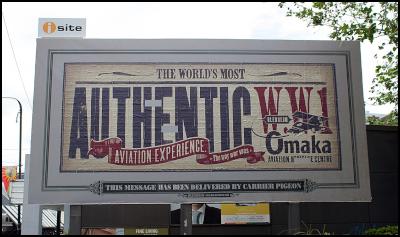Carrier Pigeons Deliver WW1 Aviation Museum Promo
Pride In Print media release (March 2008)
Carrier Pigeons Deliver WW1
Aviation Museum Promo

Ingenuity within the New Zealand advertising and print industries has been showcased by the recent flying of a Wellington billboard across Cook Strait -- via carrier pigeon!
Pieces of the Dixon Street billboard, established to promote the recent one-year anniversary of the Omaka Aviation Heritage Centre, were individually delivered by 289 pigeons released from Blenheim.
In a further reflection of the authentic WWI experience provided by the Peter Jackson-conceived museum, the components were progressively incorporated into the billboard by a worker dressed and utilising technology appropriate to the day.
Developing the billboard, which has been entered in the Pride In Print Awards, AXIS Australian Award and at the Cannes International Advertising Festival, was a considerable logistics exercise, says Clemenger BBDO production director Scott McMillan.
“The base skin went up for a couple of weeks and served as a teaser,” he says.
“The size and number of pieces used in the top skin, which was printed and installed by Mesh Digital, was determined through trial and error in conjunction with Pigeon Racing New Zealand (PRNZ).
“The perfected pieces were ultimately rolled, taped and attached to 289 pigeons and transported over to Blenheim in PRNZ trucks to be released at Omaka (all of the 268 birds made the trip to Wellington, but three of the parcels were lost in transit).
“A Mesh installer dressed as a WWI soldier then applied the pieces over one week -- every day he would spend about one hour in the hot Wellington sun dressed in thick itchy wool while lunch-goers watched the whole thing unfold.”
Mr McMillan says Mesh played a key role in trialing a number of different stocks to find one light enough and appropriate for the end result.
“It's not always just about the printed image -- it's the whole package. Over the years I have thrown a lot of really difficult and messy projects at them.
“Never once have they seen the challenge as too hard or just ink on paper. Inevitably things get messy as you get into these types of projects and things don't always run as planned. Mesh are really flexible and handle those little bumps in the road with a smile.”
Mr McMillan says his agency was “absolutely delighted” with the end result, which has gained recognition all around the world.
Mesh used an Inca Spyder digital UV flatbed machine -- understood to be the only one in the country -- to print the job on 57gsm Tyvek Synthetic paper. The Tyvek was printed and numbered on the reverse side, before being prepared for the pigeons.
ENDS


 Buy NZ Made: Beware The Black Friday 'Deal'
Buy NZ Made: Beware The Black Friday 'Deal' Little Miracles Trust: 60 Landmarks Light Up Purple To Support Babies Fighting For Life On World Prematurity Day
Little Miracles Trust: 60 Landmarks Light Up Purple To Support Babies Fighting For Life On World Prematurity Day Maia Studio: Frankie Venter Performs With Coldplay At Sold Out Eden Park Show
Maia Studio: Frankie Venter Performs With Coldplay At Sold Out Eden Park Show Royal NZ Ballet: RNZB's Tutus On Tour Returns For Summer 2025
Royal NZ Ballet: RNZB's Tutus On Tour Returns For Summer 2025 Little Miracles Trust: The Little Miracles Trust World Prematurity Day Campaign
Little Miracles Trust: The Little Miracles Trust World Prematurity Day Campaign NZ Society for the Study of Diabetes: Critical Workforce Shortages Leave People With Type 1 Diabetes Unable To Access Life Changing Technology
NZ Society for the Study of Diabetes: Critical Workforce Shortages Leave People With Type 1 Diabetes Unable To Access Life Changing Technology